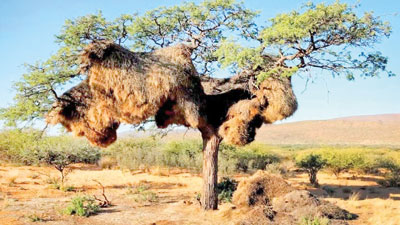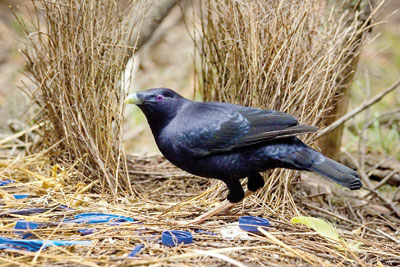Animal architects

Sociable weaver nest. Pic courtesy: http://www.look4ward.co.uk/animals/learning-from-nature-amazing-structures-built-by-animals/
The Burj Khalifa in Dubai is the world’s tallest building, with 160 storeys and towering at 829.8 metres. The Manta Resort on Pemba Island has underwater rooms where guests can watch sharks and rays floating past their beds. The Haohan Qiao Bridge in China is a glass-bottom bridge that is 179.8 metres tall and nearly 300 metres long. The pyramids of Egypt, the Colosseum of Rome, Borobudur in Indonesia and the iconic Taj Mahal of Agra stand as testaments to spectacular architects of the past.
Architecture is not new. Humans have been building since the Neolithic or New Stone Age from some 9000 BC to 5000 BC years ago.
However, animal builders have been in existence a long, long time before this — they are our planet’s first builders and they craft homes of mind-boggling designs.
Animals construct structures to a) build homes to raise their young and protect themselves against the elements or predators; b) catch or trap prey; and c) attract the opposite sex.
Colonial insects — termites, bees, wasps and ants — are champion architects. Individually tiny and vulnerable to being squashed, collectively, in a colony of millions, insects such as termites can build termite mounds that can be higher than five metres. It is estimated that the collective weight of these million termites is 15 kilogrammes, and that they can move a quarter of a metric ton of soil every year when they build these mounds using a combination of soil, saliva and excreta.
The mounds are marvels of architecture, with a complicated and extensive system of tunnels that generates ventilation and cools the air inside.This cooling is critical for these insects whose bodies would dry out in the arid environments of Africa, Australia and South America where they live. However, recent studies have shown that this complex system of tunnels does not merely generate passive air conditioning, but even functions like a giant lung to expel accumulated carbon dioxide and to pull in oxygen.
Prairie dogs — small communal mammals of the rodent family, found in the prairies of North America — go one step further, and build their own underground towns extending over some 40-50 hectares (that is, the size of 40-50 sports fields), with a maze of tunnels, defined sleeping quarters, nurseries, toilets and listening posts for predators situated close to the surface. These towns also have a built-in drainage system in case of flooding. They allow prairie dogs to raise their young in safety from predators and avoid the vagaries of the prairie weather, which can get too hot during the days in the summer and too cold at night during the winter.

The bower of the Satin bower bird (not the Vogelkop bower bird). Pic by Keren Sadanandan
In contrast, the sociable weaver of southern Africa — a relative of the common sparrow— builds apartment complexes, high above the ground. These small birds are phenomenally industrious nest builders, building giant nests up to four metres in height, in which 300-400 birds can live. From a distance, these communal nests resemble a haystack stuck up on a tree.
Sociable weavers use different materials for different sections of the nest: large twigs and stems for the roof of the nest and grasses poked in between; grass spikes fencing tunnel entrances to deter predators; while nesting chambers are lined with soft materials, such as feathers, fluff, wool, or hair.
The advantage of this mammoth nest is again for protection against the elements and predators. During the day, the thatched roof of the nest keeps it cool from the scorching sun, and in the night, when the temperature drops sharply, the heat retained in the nest, keeps the colony of birds warm.
The north American beaver — another rodent — is second only to humans in its capacity to alter its environment, and is a master engineer, who gnaws through and fells trees across rivers, and then builds dams using boulders like bricks and mud like cement for construction, creating not merely a city or an apartment but an entire ecosystem — a wetland— safe from predators. Within this wetland, it constructs its home — called a lodge – a fortress of boulders and branches, so strong that a bear cannot break in. Beavers dig burrows underground into the wood around where they feed on plant material and then retreat to the safety of their wetland. These ecosystem engineers alter the flow of rivers, prevent erosion and raise the water table, purifying water as silt builds up and adsorbs toxins. All these changes attract a range of other species, such as invertebrates, amphibians, fish and birds.
Just as prey evolve mechanisms to avoid predators, predators go to great lengths to catch prey. Spiders produce silk protein from structures called spinnerets in their stomachs and weave webs to trap their prey. Trapdoor spiders do not weave webs like other spiders, but live in burrows which they did underground. They construct doors for these burrows using silk from their bodies, plant material found in the environment and soil. They then ingeniously make a hinge for these doors with silk and booby trap the surrounds also with their silk, close the perfectly camouflaged door, and wait underneath it. When an unsuspecting animal trips the booby trap, the spider springs out and kills it.
Animal architects also build to attract mates. The drab bower birds of Australia and New Guinea are extraordinary builders and decorators, where the male builds a bower for his mate and decorates it with various objects such as berries, flowers, shells, drinking straws, keychains and bits of plastic. The female chooses the best decorated and neatest nest. Among these astonishing builders, is the Shan Jahan of bower birds, the Vogelkop bower bird who builds a cone-shaped metre-high bower, woven around a central sapling, which he then carpets with moss. He carefully decorates the entrance with flowers, berries and coloured stones, all arranged according to an intricate pattern of colours. This process takes nearly a year, during which the male assiduously cleans and rearranges the area. Each bower is different as each male prefers a different set of colours.
In a world where we have over-used natural resources, destroyed natural habitats and poisoned the air and water to alter the environment to suit us, it may benefit us well to turn to nature and learn from it.
We may now be striving for sustainability, but a sustainable world already exists in nature which has fine-tuned its products during a 3.8 billion year period. Termite mounds have a sophisticated air-conditioning system that uses no fossil fuels to keep the structure at a temperature that fluctuates only within one degree Celsius, while we humans use 20% of the world’s energy to keep buildings in cities at similar temperatures. Corals are tiny colonial marine animals that extract calcium carbonate from the sea and secrete it as a cup of calcium carbonate from the bottom half of their bodies, building great ramparts of coral reefs. In doing so they lock in this carbon. In contrast, when we use cement to build infrastructure, approximately 900 kilogrammes of carbon dioxide are released into the atmosphere when each tonne of cement is made, contributing to global warming, We extract natural resources, turn them into short-lived products and after using them, we chuck them out as waste. Nature, on the other hand, never throws anything away — what is waste for one organism becomes food for another and is eventually recycled as nutrients into the ecosystem.
As Janine Benyus writes, ‘Nature runs on sunlight. Nature uses only the energy it needs. Nature fits forms to function. Nature recycles everything. Nature rewards cooperation. Nature banks on diversity. Nature demands local expertise. Nature curbs excesses within. Nature taps the power of limits.’
Benyus coined the word biomimicry to popularise this concept of looking to nature to provide sustainable solutions. In the last three decades, this branch of science has grown and developed producing some inventive solutions to our planet’s problems.
Inspired by the self-sustaining air-conditioning systems of termite mounds, Zimbabwean architect Mike Pence designed the Eastgate Building, an office complex in Harare. Made mainly of concrete, this building has a ventilation system which draws outside air using fans into the building and this air is warmed or cooled by the building depending on which is hotter, the building concrete or the air. This air is then circulated through the building before it is sent out, again by fans through chimneys at the top. This building uses 90% less than the energy of a conventional building its size and its owners have saved 3.5 million USD by not installing an air-conditioning system, excluding the cost of running it daily.
Matthew Parks of Atlas Industries looked at the Fogstand beetle of the Namibian Desert which lives in a harsh, arid climate where water is scarce. In the nights, when fog collects in the air, this beetle raises its back into the air. Parts of its shell-like external skeleton is waxy and repels water, while other part of it has bumps that collect the water as droplets, which then runs down along chutes towards the beetle’s mouth. Park designed the Namibian Hydrological Centre of Excellence, called the ‘Fogcatcher’ with ‘sails’ to catch water from the desert fog, to meet the growing challenge of finding drinking water in a desert area. Pak Kitae of the Seoul National University of Technology, had a simpler solution, making a Dew Bank Bottle that similarly collects morning dew on a bottle.
One of the most elegant biomimicry innovations is the Cardboard to Caviar project, that imitates the closed loop of an ecosystem’s recycling processes. Graham Wiles, the CEO of the non-profit Green Business Network (GBN) in Yorkshire, commenced this project as work rehabilitation for recovering heroin addicts. Restaurants pay the GBN to take cardboard from their premises. GBN does so, shreds it and sells it as horse bedding. Eventually, the bedding needs replacement, and the stable owners pay GBN to replace it. GBN takes the soiled bedding and feeds it to worms to make compost. The compost nourishes plant beds and the extra worms are fed to the sturgeon in a fish farm. Caviar is produced from these fish, and sold back to the restaurants where the cardboard was collected in the first place. This is an excellent example of how every link in an ecosystem reuses waste and recycles nutrients. That it takes the pressure off the endangered wild sturgeon, is an added bonus.
These are exciting innovations that can change the way we think and, the way we can live sustainably, in harmony with the Earth. In order to do so, we must stop ravishing the earth of its bounty and learn to look and listen to the lessons it gives us freely.


